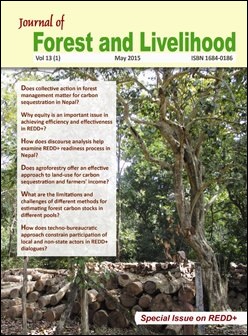Collective Action and Carbon Sequestration in Nepal
DOI:
https://doi.org/10.3126/jfl.v13i1.15360Keywords:
Carbon, Collective action, Nepal, REDD, SequestrationAbstract
This paper uses forest plot measurements and information on forest collective action to estimate the effects of collective action on four measures of forest quality (e.g., carbon content, tree density, seedling density and canopy cover) in Nepal. Carbon sequestration is of special interest because it may be creditable under Reducing Emmission from Deforestation and Forest Degradation (REDD+). We find that community forest collective action sequesters carbon and appears to support several other forest quality measures. Even though registered community forests sequester more carbon than other forests, we find that non-registered community forests also show evidence of important collective action, with positive effects on forests.
Journal of Forest and Livelihood 13(1) May, 2015, page : 1-7
Downloads
Downloads
Published
How to Cite
Issue
Section
License
CC-BY-NC: This license allows reusers to distribute, remix, adapt, and build upon the material in any medium or format for noncommercial purposes only, and only so long as attribution is given to the creator.





